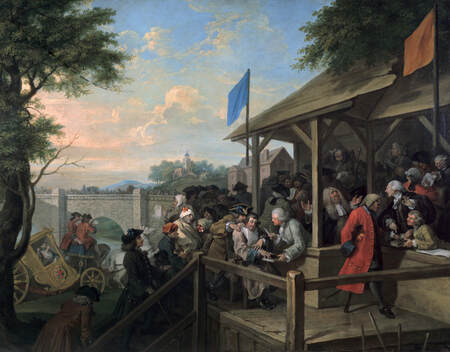 The Polling -- William Hogarth
The Polling -- William Hogarth In early democratic systems, the voting franchise was limited to relatively small number of the nobility and landed gentry. Being social familiars, the voters often treated elections as a social affair at which an open debate might be held to discuss which of the eligible persons present should be "elected" to serve.
As the franchise expanded beyond the noble and landed classes, employers and landowners had been able to use their sway over employees and tenants to influence the vote, either by being present themselves or by sending representatives to check on the votes as they were being cast. Small retailers were also concerned not to upset their bigger customers by voting differently from them.
The painting The Polling (1755) by William Hogarth depicts a typical election before the introduction of the secret ballot. The colored flags presented the two parties and voters gathered by the flag of their party and announced their vote by calling out their name and the name of the party (not the candidate) they supporting which was then recorded in a register. Note the carriage in the background on the left, indicating that the local squire is observing how his tenants vote.
The first use of a secret ballot was in France in 1848, and subsequently in Australia, where the adoption of four requirements for the manner of voting in secret became known as the "Australian ballot system." The requirements were:
- an official ballot being printed at public expense,
- on which the names of the nominated candidates of all parties and all proposals appear,
- being distributed only at the polling place and
- being marked in secret.
The Ballot Act 1872 was an Act of the Parliament of the United Kingdom that introduced the requirement for parliamentary and local government elections in the United Kingdom to be held by secret ballot. Radicals, such as the Chartists, had long campaigned for the system to end by the introduction of a secret ballot.
The Representation of the People Act 1867, or Second Reform Act, enfranchised the skilled working class in borough constituencies, and it was felt that their economic circumstances would cause such voters to be particularly susceptible to bribery, intimidation or blackmail. The radical John Bright expressed concerns that tenants would face the threat of eviction if they voted against the wishes of their landlord. It fell to Edward Aldam Leatham, the husband of Bright's sister, to introduce the Ballot Act on leave.
Many in the Establishment had opposed the introduction of a secret ballot. They felt that pressure from patrons on tenants was legitimate and that a secret ballot was simply unmanly and cowardly. Lord Russell voiced his opposition to the creation of a culture of secrecy in elections, which he believed should be public affairs. He saw it as 'an obvious prelude from household to universal suffrage'.
Election spending at the time was unlimited, and many voters would take bribes from both sides. While the secret ballot might have had some effect in reducing corruption in British politics, the Corrupt and Illegal Practices Prevention Act 1883 formalized the position and is seen by many to have been the key legislation in the attempts to end electoral corruption.
The secret ballot mandated by the Act was first used on 15 August 1872 to re-elect Hugh Childers as MP for Pontefract in a ministerial by-election, following his appointment as Chancellor of the Duchy of Lancaster. The original ballot box, sealed in wax with a liquorice stamp, is held at Pontefract museum.[11] Of those who voted, 16%, were illiterate, and special arrangements had to be made to record their previously-open oral votes. The first general election using a secret ballot was in 1874, which saw the first Conservative majority elected since 1841.
The Ballot Act 1872 was of particular importance in Ireland, as it enabled tenants to vote against the landlord class in parliamentary elections. The principal result of the Act was seen in the general election of 1880, which marked the end of a landlord interest in both Ireland and Great Britain.
The Act inspired Belgian minister Jules Malou to implement a similar system in Belgium, which he did with the act of 9 July 1877 (la loi du 9 Juillet 1877 sur le secret du vote et les fraudes électorales). The elections of 1878 were a victory for the Liberal Party.
 RSS Feed
RSS Feed